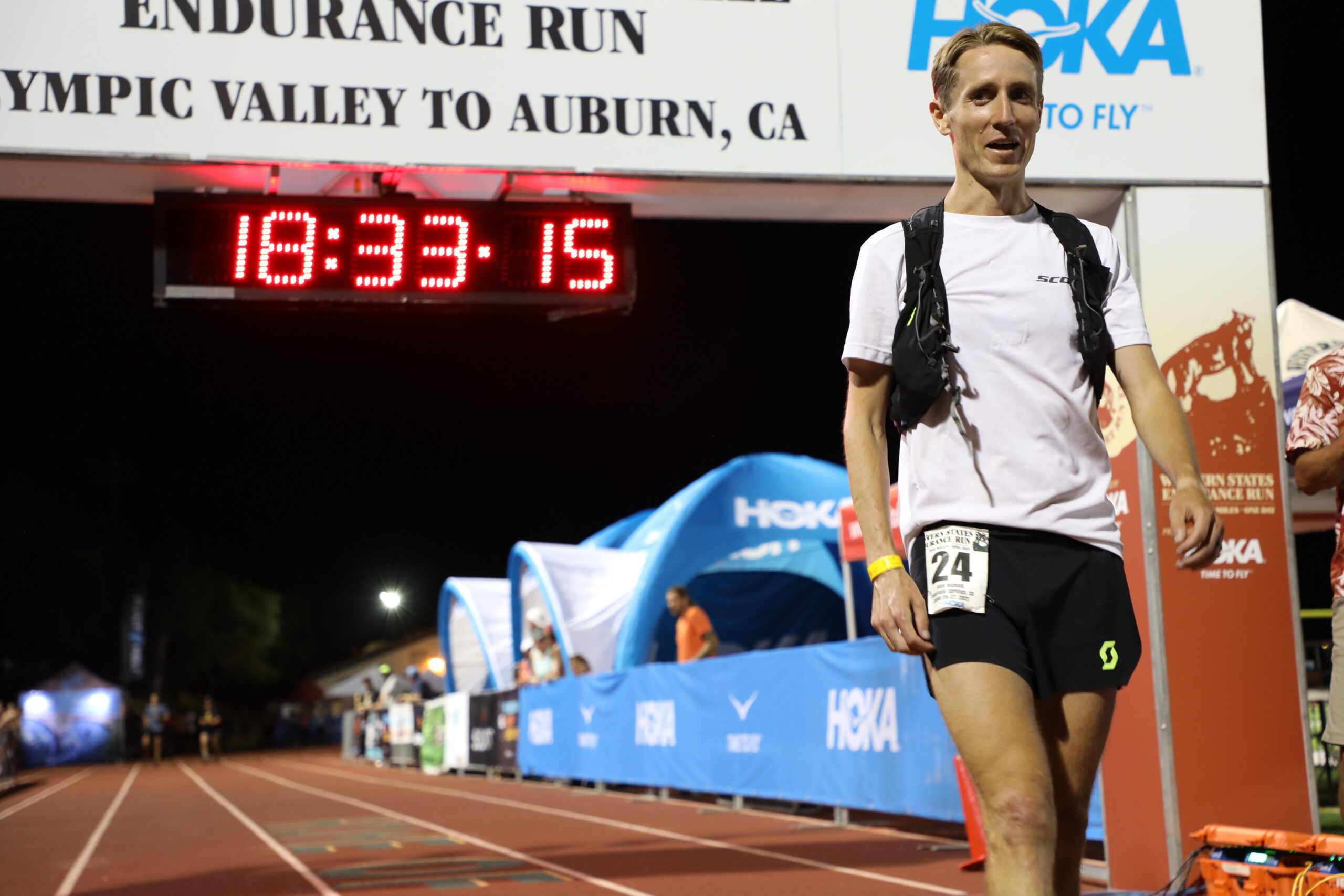The dust has settled after the 2021 edition of the Western States 100, this is a good opportunity to take a look at what happened and lessons learned from the race. This year was my second Western States after placing second in 2017. With a year of solid training and prior knowledge of the course, I was confident going into the race. In contrast to 2017, this year’s race featured an entirely snow-free course, so I hoped to run faster. I knew the heat would be a factor later in the race, but I felt prepared to handle the high temperatures. On paper, this year should have been faster. However, at least for me, it turned out to be just the opposite. I finished well outside of my goals, and about two hours slower than in 2017. Now that I have had a chance to consider how the race played out, I realize I failed to follow one of the most important pieces of advice that I give to runners: run your own race.

Alex Nichols makes his way up toward Robinson Flat during the 2021 Western States 100. All photos: iRunFar
There is significant evidence that endurance athletes achieve optimal performance when an even pacing strategy is adopted, whether it is a 5,000-meter track race, or a 24-hour trail race (1). A perfectly even pace doesn’t make sense in a mountainous race like Western States because of the changes in trail grade and conditions, but an even overall running speed with fewer fluctuations has been shown to lead to faster finish times (2). Despite this evidence, many runners adopt the “herd mentality” (2). Competitors run the first few hours of an endurance event at a much faster pace than their overall average to keep up with the runners around them. The herd mentality leads to a significant decrease in speed and a slower finishing time. This is what happened to me during this year’s Western States: I got caught up in someone else’s race.
Early in the race, I ignored plenty of warning signs, though I didn’t process it at the time. My first couple of splits hit right on and I felt good as we made our way through the high country. After the mile 10 aid station, I found myself pushing slightly outside my comfort zone to keep up with Max King and Drew Holmen. I told myself I was enjoying the company, and I could slow down a bit once we hit the next big climb. Yet I still ran faster and faster splits. I believed I was just giving myself a cushion on the later parts of the race when things would inevitably heat up. I realize now that I wasn’t giving myself a cushion, I was digging my own grave. Caught up running someone else’s race, I paid the price in the heat of the day.

Alex Nichols makes his way out of the canyons toward Michigan Bluff with Tim Tollefson right behind.
Why is running our own race so hard to do, especially if we know that it leads to the best outcome? The herd mentality is obviously a major factor in poor pacing. It leads to a disregard of race planning and early mistakes grow into race-crushing problems in the later stages of ultramarathons. So how can we avoid the herd mentality and focus on running our best races? Here are a few tips I should have followed at this year’s Western States.
Trust the Pre-Race Plan
When I noticed my splits were getting faster and faster early in the race, I should have known something was off. I did my homework and put together a plan that would give me a chance to run strong later in the race, but in the heat of the moment I completely disregarded that plan. Race-day decisions can’t be trusted in ultra racing. We need to trust our pre-race plans and follow those instead of getting caught up in the heat of competition.
Ignore the People Around You
The competitive spirit often takes hold early when thrown into the heightened atmosphere of race day. However as the race distance increases, it becomes even more important to avoid the urge to really race. The first half of a 100-mile race shouldn’t feel like a race. That means ignoring the runner who just passed you on the last downhill and trusting that they will come back to you in the last 40 miles when you are picking off the people who got caught up in the herd early on.
Consider Your Goal Pace
A 24-hour 100-mile race pace is just a bit faster than four miles per hour. If you are shooting for a 24-hour finish and find yourself running 10-minute miles early on, take a moment to consider that you are five minutes per mile ahead of your overall finishing pace. That’s just an example, but it can be worth having a straightforward conversation with ourselves early in long races to ensure we are making good decisions. I could have used that when I was 15 minutes ahead of my goal split at mile 30. That kind of math does not add up to a strong finish in any ultra.

Alex Nichols crosses the finish line in 18:33:15 at the 2021 Western States 100.
The fastest runners in ultra-distance races are the ones who start at a lower intensity (relative to their average race speed) and display an even pacing strategy compared to slower opponents (2). Those runners are running their own races, but they will inevitably pull others along in their wake. Ultramarathons are especially hard to gauge our personal race efforts because they feel so easy compared to normal race-pace situations. This is why it is so important to develop a pre-race plan and stick to it. I know things would have been different in my last 40 miles of the 2021 Western States if I had pulled back after the first few splits were too fast. Understanding proper pacing and executing it are two very different things, but realizing our mistakes and learning from them is the first step to improving for the next race.
Call for Comments
- Have you gotten caught up in not following your race plan? What happened next?
- Have you successfully followed your race plan, even when it was difficult because of how good you felt early on or what others around you were doing?
References
- Abbiss, C. R., & Laursen, P. B. (2008). Describing and understanding pacing strategies during athletic competition. Sports Medicine, 38(3), 239–252.
- Bossi, A. H., Matta, G. G., Millet, G. Y., Lima, P., Pertence, L. C., de Lima, J. P., & Hopker, J. G. (2017). Pacing strategy during 24-Hour ultramarathon-distance running. International Journal of Sports Physiology and Performance, 12(5), 590–596.
